Corsair MM800 RGB Polaris Mouse Pad Review
Pros
Cons
Rating
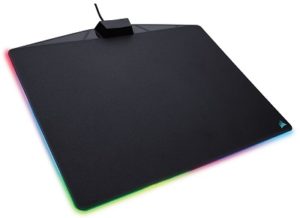
Introduction
Anyone following the PC market over the past year or so probably knows that LED lighting is all the rage. You’ve got your RGB motherboards, RGB video cards, RGB case fans, RGB headsets, RGB keyboards, and RGB mice. There’s honestly not a whole lot left that doesn’t have RGB lighting. RAM comes to mind, and we have a feeling Corsair is in the very best position to offer it! But apparently before it tackles that market, it’s going straight for its archrival Razer with the new MM800 RGB Polaris Mouse Pad. Razer introduced its pioneering Razer Firefly mouse mat at CES 2016, and we were there to ask Razer why. Well, it was simple: they’d already RGB’ized everything else in their lineup! And we have no doubt the Firefly has been a big hit, especially among die-hard Razer fans, of which there are many.
But Corsair is a company focused on performance, not aesthetics, so if it were going to challenge the Firefly, it was going to do it with a focus on the fundamentals. Corsair offers a number of high-performance mice and mouse mats, so its first foray into RGB mats had to live up to the high bar set by those products. Read on to find out what it’s doing right with the MM800, as well as areas where we see room for improvement.
We’d like to extend a special thank you to Corsair for providing us with a review sample of the MM800 RGB Polaris Mouse Pad.
Description and Features
The MM800 is a fairly large mouse pad, measuring 13.8″ x 10.2 ” x 0.20″, which interestingly enough is nearly identical to the Razer Firefly, which measures 14” x 10” x 0.16”. It appears that both Corsair and Razer are moving towards the widescreen-equivalent of mouse pads, as older models, including Corsair’s MM300, as well as the ultra-popular Steelseries 4HD, are a bit more square in shape. The wider mousing area makes a lot of sense for gamers, at least in theory, due to the freedom to move from side-to-side . For general use, however, it causes a bit of an issue in that to keep a keyboard centered below the monitor in an ergonomic typing position, the far end of the MM800 really can’t be used, effectively making the usable mousing area narrower. If you’re a hard-core gamer using a tenkeyless keyboard like the Corsair K65 RGB, this will be less of an issue.
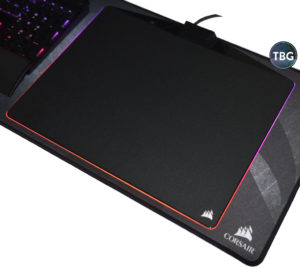
One great feature of the MM800 is the USB pass-through port positioned just to the right of the braided USB cord. That’s something the Razer Firefly strangely left off, but it’s just the ticket for smoother gaming with a wired mouse. There’s nothing worse than getting your mouse cord caught up in the mess of cables behind your desk while performing a fast-paced maneuver.
With regard to the mat material, Corsair could have gone a number of ways. There’s the classic cloth option, which is comfortable and won’t wear out your mouse feet, there’s the faster smooth plastic surface, which typically gets scratched pretty easily, and then there’s the long-wearing textured plastic surface for minimal friction. Corsair went with the latter, which means the MM800 is a very fast mat, but it’s a bit uncomfortable to drag the side of your fingers across, as you might while gripping your mouse, and will also prematurely wear out the glide pads on any mouse. That’s the tradeoff you make, but there’s no doubt the MM800 is responsive. Compared back to back with our Corsair MM300 Extended Cloth Mat, which can be seen sitting underneath the MM800 in our photos, the MM800 is like gliding on ice. Sure cloth is smooth, but it’s not fast.
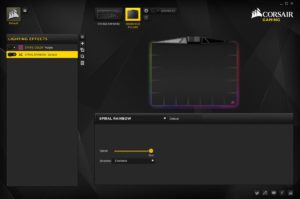
The big news on the software side is Corsair’s brand-new Corsair Utility Engine 2, released at PAX West 2016 with much fanfare, which was warranted given how badly CUE needed an update. We have to hand it to Corsair: they didn’t just give CUE a nip-and-tuck; this is a whole new suite. Finally offering an interface to rival Logitech’s LGS and Razer’s Synapse, CUE 2 is nice to look at and nearly as nice to use. The interface is big and bold, and you can easily see all your connected Corsair gear up top. For marketing purposes, though, CUE 2 by default “demos” other gear you don’t have, a feature we shut off as soon as we found the option in the settings menu. The idea is that you can see the various lighting schemes that could be applied the RGB family, but it gets confusing if you actually have a lot of gear connected.
CUE 2 lets you create and save a seemingly-unlimited number of profiles, and even allows interesting mash-ups like turning on multiple profiles at once. For example, in the screenshot here, we did a mashup of the spiral rainbow pattern with a static purple color, which basically gives you a rainbow built off the purple color. Very cool! You can change directions and speeds of the color cycles, link various products together using the “Lighting Link” option, or go whole-hog and set up a custom gradient, which you’ll see in a moment.
Since lighting is part and parcel of the MM800’s “performance”, we’re going to go into more detail on the use of CUE 2, along with the mouse mat performance, next.
Performance
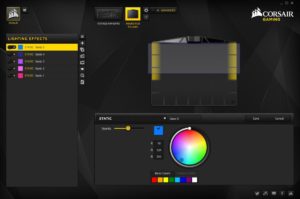
Overall, CUE 2 is a powerful software suite, but with great power comes great responsibility… or something like that. Anyway, you can do a lot of things with it, but the features still don’t make a ton of sense. It feels like a public beta to us. The “apply color” checkbox isn’t intuitive. We were told at PAX West 2016 that it was added so you could see it on screen before you changed your actual hardware setting, but it leads to a lot of steps to do anything. We also find it confusing that you must drag across lighting zones on the image of your Corsair peripheral to apply colors to them, as shown below. Why not right click or control-click, Corsair? In fact, even to apply one color to the entire mat, you have to drag across the screen, which is pretty silly. The default should be to “paint” the entire product one color, rather than having to “select” it. Also odd is that in the Advanced menu, the MM800 goes dark while you’re changing profiles, and won’t light up again unless you switch to another menu. Strange.
Ultimately, though, a mouse mat is there to make your computing experience smoother, so if the MM800 is to be judged on the merits, we have to determine whether it has the performance to back up its colorful appearance. Below is the list of gear we tried it out with. We think it’s pretty critical that any test of high-speed peripherals is done on a machine that won’t slow things down, so we used an overclocked eight-core Broadwell-E processor, a high-end video card setup, and a 144Hz G-Sync monitor (the latter which is critical if you’re serious about actually taking advantage of low-lag peripherals). Our full setup was as follows:
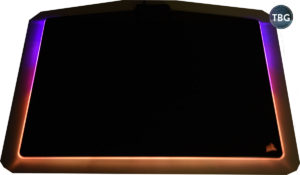
- CPU: Intel Core i7-6900K (overclocked to 4.3GHz)
- Motherboard: Asus X99-Pro/USB 3.1
- Memory: Corsair Vengeance LPX 4x8GB DDR4-3200
- Solid-State Drive #1: Samsung 950 Pro 512GB
- Solid-State Drive #2: Samsung 850 Evo 1TB
- Video Cards: 2x EVGA GeForce GTX 1080 SC 8GB
- Power Supply: EVGA Supernova 1000 PS
- Case: SilverStone Primera PM01
- CPU Cooler: Corsair Hydro H100i v2
- Operating System: Windows 10 Home
- Monitor: Acer XB270HU 144Hz G-Sync
In addition to all the hardware above, perhaps the most important component of our test was the mouse, or should we say mice, that we used. While we have previously reviewed several Corsair mice, we believe Logitech mice actually offer the best performance. So we used the Logitech G502 Proteus Spectrum and Logitech G403 Prodigy Wireless gaming mice. Our keyboard of choice, as pictured on this page, was the Corsair K70 RGB Rapidfire.
Right off the bat, we encountered some problems with the MM800’s connectivity, in that it would often drop the connection from our system, showing up as “greyed” out in CUE 2, and reverting to its default rainbow spiral color scheme. That luckily doesn’t affect your gaming session (unlike a dropped mouse connection), but it’s still frustrating. We have a feeling this may have to do with insufficient USB power, as it’s something we’ve seen when using various other RGB gear on Asus boards. The good news is that we couldn’t replicate the issue on our Gigabyte GA-Z170X-Gaming 6 board, so perhaps it’s limited to certain Asus boards.
Once we started up some gaming sessions, we came to appreciate the ultra-slick surface of the MM800 (and came to forget that it has RGB lights, for better or for worse). The rough surface that seems a bit off-putting when you first feel it against the side of your hand quickly proves itself to be all about performance. In fact, it accelerates mouse movements so much that you may need to turn your mouse DPI setting down until you get used to the speed. Don’t forget to take advantage of your mouse’s tuning surface option if it’s offered, as this can really help the mouse adapt to different surfaces. A textured plastic surface is truly nothing like a cloth mat.
Below, you ‘ll see how we ultimately set up our Corsair gear, using a static color gradient we hand-picked using the CUE 2 software. Each of the K70’s seven horizontal rows were given a different color, while each of the MM800’s five horizontal zones were likewise given a matching color. We think the final look is seriously cool.

Conclusion
If you picked up on a bit of sarcasm earlier in this review when we counted the ways in which RGB has become a craze, you were onto something. We think flashing lights look better on a show floor than on your desk, and ultimately, we recommend products based on performance, not flare. But to the extent that RGB lighting can add style to a PC setup without adversely affecting performance, it’s fair game. Not too long, standard keyboard backlighting probably seemed superfluous, so you never know. And indeed, with the MM800 and the impressive K70 line of RGB keyboards powered by the newly-polished CUE 2 software, you can do more than blow up your desk with a bling-bling spiral rainbow (although, we admit it looks really cool from afar!). The key to Corsair’s approach is the power to customize. The MM800’s 15 zones mean you can really set up what looks like one continuous spectrum, and frankly it looks more beautiful in static form than in its more dazzling spiral, wave, or raindrop forms. You can of course also just choose one specific color too, if all you want is a little lighted accent at your workstation, or select different colors for different applications (red, for example, if you’re dropping enemies with your razor sharp mouse skills, perhaps?). Anyway, to the extent a PC can play a role in home décor, RGB peripherals definitely have their place.
And while we hate to feed the flames and potentially incite an all-out color war, if Corsair is serious about its RGB peripherals, it’s got to expand its mouse line to go beyond what the M65 Pro RGB is capable of. In our opinion, you really shouldn’t market a product as RGB if it only has two lighting zones. By our count, that’s RG, or GB, but not RGB! A true RGB mouse better offer all the colors of the rainbow at once, as can the Razer Mamba and Roccat Kone, which both feature gorgeous RGB light pipes that seriously class up their designs. We spoke with Roccat at CES 2016, and they were clearly a bit miffed that Razer cribbed the lightpipe design Roccat introduced way back in 2012, in the process likely outselling Roccat by about a bazillion to one. Well, that’s business, and we’re guessing those lightpipes aren’t patented, so Corsair better get on board, because it’s the only way to make an RGB mouse look like it belongs on the impressive MM800.
The Corsair MM800 RGB Polaris Mouse Pad has an MSRP of $59.99, but was not available at retail when this review went to press. As of our latest update, it’s available for $56 shipped from Amazon.
For more on the best in PC peripherals, check out our Peripherals Buyer’s Guide, as well as our Speaker/Headset Buyer’s Guide, both updated quarterly with all the best products at every price point!


